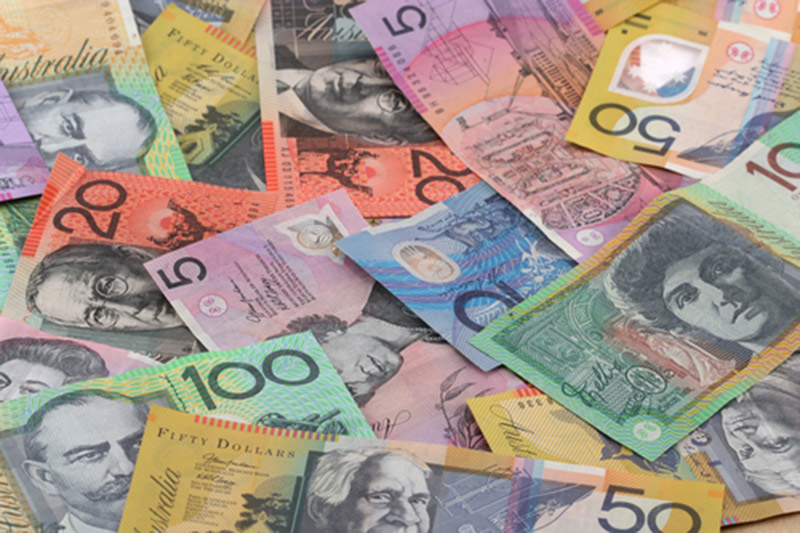Investing.com - The Australian dollar held weaker in early Asia on Friday as investors awaited a gauge on China manufacturing in the wake of the European Central Bank's large easing program.
AUD/USD traded at 0.8014, down 0.12%, while USD/JPY changed hands at 118.49, down 0.02%. EUR/USD traded at 1.1365, up 0.03%.
First up, the HSBC China flash manufacturing PMI, which is closely tracked by the market, could be a key event for risk sentiment.
This is due at 0945 local time (0145 GMT). There's not much chance of a significant improvement in the headline reading over December's fall to a seven-month low of 49.6.
Then in Japan, at 1300 Tokyo time (0400 GMT), Japan's former economic and fiscal policy minister, Hiroko Ota, speaks on the outlook for the Japanese economy and
Abenomics at the Foreign Press Center.
Overnight, the dollar climbed to fresh 12-year highs against the other major currencies on Thursday, after the release of relatively positive U.S. jobless claims data and as the European Central Bank announced a large scale quantitative easing program.
In a report, the U.S. Department of Labor said the number of individuals filing for initial jobless benefits in the week ending January 17 decreased by 10,000 to 307,000 from the previous week’s total of 317,000.
Analysts had expected initial jobless claims to decline by 17,000 to 300,000 last week.
The U.S. dollar index, which measures the greenback’s strength against a trade-weighted basket of six major currencies, was quoted down 0.22% at 94.45 in early Asia.
EUR/USD tumbled 1.41% after ECB President Mario Draghi said it will make monthly purchases of €60 billion per month, starting in March and continuing until late 2016.
Draghi acknowledged the action the ECB took last year was “insufficient” to ward off the threat of deflation in the region. The annual rate of inflation in the euro area fell into negative territory last month, dropping 0.2%.
Draghi said the risks to the euro area recovery remain to the “downside” but added that today’s action should bolster the outlook. He noted that lower oil prices should help households and support a wider recovery.
- English (UK)
- English (India)
- English (Canada)
- English (Australia)
- English (South Africa)
- English (Philippines)
- English (Nigeria)
- Deutsch
- Español (España)
- Español (México)
- Français
- Italiano
- Nederlands
- Português (Portugal)
- Polski
- Português (Brasil)
- Русский
- Türkçe
- العربية
- Ελληνικά
- Svenska
- Suomi
- עברית
- 日本語
- 한국어
- 简体中文
- 繁體中文
- Bahasa Indonesia
- Bahasa Melayu
- ไทย
- Tiếng Việt
- हिंदी
Forex - Aussie weaker in early Asia with focus on flash HSBC China PMI
Published 01/22/2015, 05:25 PM
Updated 01/22/2015, 05:26 PM
Forex - Aussie weaker in early Asia with focus on flash HSBC China PMI

Latest comments
Install Our App
Risk Disclosure: Trading in financial instruments and/or cryptocurrencies involves high risks including the risk of losing some, or all, of your investment amount, and may not be suitable for all investors. Prices of cryptocurrencies are extremely volatile and may be affected by external factors such as financial, regulatory or political events. Trading on margin increases the financial risks.
Before deciding to trade in financial instrument or cryptocurrencies you should be fully informed of the risks and costs associated with trading the financial markets, carefully consider your investment objectives, level of experience, and risk appetite, and seek professional advice where needed.
Fusion Media would like to remind you that the data contained in this website is not necessarily real-time nor accurate. The data and prices on the website are not necessarily provided by any market or exchange, but may be provided by market makers, and so prices may not be accurate and may differ from the actual price at any given market, meaning prices are indicative and not appropriate for trading purposes. Fusion Media and any provider of the data contained in this website will not accept liability for any loss or damage as a result of your trading, or your reliance on the information contained within this website.
It is prohibited to use, store, reproduce, display, modify, transmit or distribute the data contained in this website without the explicit prior written permission of Fusion Media and/or the data provider. All intellectual property rights are reserved by the providers and/or the exchange providing the data contained in this website.
Fusion Media may be compensated by the advertisers that appear on the website, based on your interaction with the advertisements or advertisers.
Before deciding to trade in financial instrument or cryptocurrencies you should be fully informed of the risks and costs associated with trading the financial markets, carefully consider your investment objectives, level of experience, and risk appetite, and seek professional advice where needed.
Fusion Media would like to remind you that the data contained in this website is not necessarily real-time nor accurate. The data and prices on the website are not necessarily provided by any market or exchange, but may be provided by market makers, and so prices may not be accurate and may differ from the actual price at any given market, meaning prices are indicative and not appropriate for trading purposes. Fusion Media and any provider of the data contained in this website will not accept liability for any loss or damage as a result of your trading, or your reliance on the information contained within this website.
It is prohibited to use, store, reproduce, display, modify, transmit or distribute the data contained in this website without the explicit prior written permission of Fusion Media and/or the data provider. All intellectual property rights are reserved by the providers and/or the exchange providing the data contained in this website.
Fusion Media may be compensated by the advertisers that appear on the website, based on your interaction with the advertisements or advertisers.
© 2007-2024 - Fusion Media Limited. All Rights Reserved.